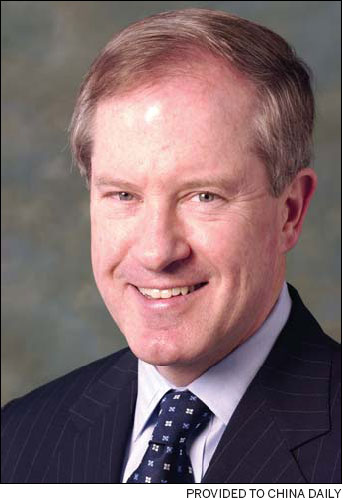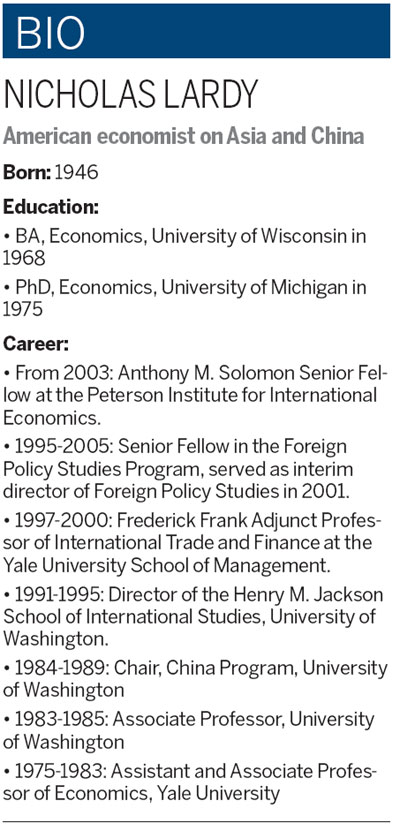One country, two road maps: an expert's view
Updated: 2012-03-09 07:35
By Chen Weihua (China Daily)
|
|||||||||

Nicholas Lardy gives his take on a recent World Bank report
Areport issued a week or so ago by the World Bank and the Development Research Center of China's State Council caused a stir in China and around the world. Titled China 2030: Building a Modern, Harmonious and Creative High-Income Society, it sought to lay out where the country should be heading over the next 18 years.
But in January Nicholas Lardy, an economist, had already unfurled a road map of his own for the country.
His book Sustaining China's Economic Growth after the Global Financial Crisis, published in January, offers policy recommendations that resonate with China 2030. Yet they are not exactly the same.
A senior fellow at the Peterson Institute for International Economics based in Washington, Lardy heaps praise on the World Bank report as "very good and very comprehensive" since it deals with everything from green development and interest rate liberalization to the social safety net and reform of State-owned enterprises (SOEs).
But he has two criticisms of the report. "It didn't really identify priorities. In fact, it identifies six priorities. It's just about covering the waterfront. Everything is important," says Lardy, a prolific writer on the Chinese economy.
"I think in the Chinese system they should say this is the No 1 priority," Lardy said at a seminar in New York recently hosted by the National Committee on US-China Relations, where he serves as vice-chairman of the board of directors. "This is the No 2 priority. This is the sequence. When you put (out) a 500-page report and say you're going to change everything, nothing happens."
He then corrected himself, saying, "Or nothing may happen. I should not be so predictive."
Lardy also thinks the World Bank report's failure not to delve into the question of why the reforms have not been carried out in the past is a problem.
He cites the example of a highly redistributive system in China, which he talks about at length in the book.
"I don't think many people in China understand how redistributive it is. Segments, geography and bureaucracies that have benefited from this system are not going to give up easily. The biggest losers are, of course, savers.
"It really has to focus on who is gaining from the system. Then you have a better chance to change the system than you do in the absence of those insights," says Lardy, who joined the Peterson Institute in 2003 after working eight years as a senior fellow in the Foreign Policy Studies Program at the Brookings Institution.
Lardy also thinks differently when it comes to the role of SOEs, which the World Bank report says are too big.
To Lardy, the biggest problem is not SOEs, but the financial sector.
"I think the private sector has been doing very well. It's a myth that the State is taking over everything," he tells China Daily after the seminar.
In his book, Lardy offers his insight on the so-called guojin, mintui (advance of the state, retreat of the private). He argues that while the government launched no important reform measures to enhance the role of the market during the stimulus program, the momentum generated by earlier market-oriented reforms continues to pay out in very important ways.
Lardy finds that the stimulus program did not fundamentally change the nature of resource allocation in China's economy by enhancing the role of the State at the expense of the market, and he cites figures of fast-growing bank lending to households and private firms.
With supporting data in his book, Lardy dismisses the notion that SOEs have expanded their footprint everywhere, but in fact there are only isolated cases such as in the nationalization of small coal mines.
According to Lardy, the industrial output contributed by SOEs continued to fall in 2009-10 and SOEs continued to underperform the private firms in the export sector. In the two years before the crisis, private firms' assets grew by an average of 37 percent, twice the 18 percent average rate for SOEs.
"The stimulus program did not lead to a wholesale advance of the State at the expense of either private firms or individual businesses," Lardy says.
The 65-year-old, who taught at Yale University and the University of Washington, has often praised China's stimulus program compared with the US program.
"China's economic stimulus program was far from perfect. But the political system did generate a rapid and reasonably coherent response that was successful in bringing China through the biggest global economic crisis in several decades with relatively strong growth momentum."
However, Lardy is deeply concerned about the sustainability of China's economic growth over the years to come, mainly the imbalances, internally and externally.
Otherwise, "the policy mix that brought China so well through the biggest global financial and economic crisis in several decades will be less successful", Lardy says.
His prescription for addressing China's imbalances and sustain economic growth includes further liberalizing interest rates to give people high returns and make property a less preferred asset, correcting factor prices that now favor manufacturing industry, introducing more flexibility in the exchange rate to allow market forces to play a bigger role, and building a social safety net.
Lardy is alarmed about the excessively high proportion of investment in gross domestic product which has consistently exceeded 40 percent since 2003, a level well above that of even China's East Asian neighbors during their periods of highest investment. At the same time, China's consumption in the share of GDP is the lowest of any country that has data.
That, according to Lardy, has led to suppressed levels of household spending and correspondingly lower levels of household welfare.
He also worries about the oversized manufacturing sector and an undersized service sector, which he believes is fueled primarily by an undervalued currency and domestic factor prices that benefit the manufacturing sector.
He sees problems in the declining share of household income in the GDP since 1992 and an increasingly high saving rate, all of which he describes as a result of financial repression.
The possibility that the property bubble will burst has become a hot issue over the years, and Lardy says he has tried to avoid expressions like property bubble or bursting bubble.
"I don't think there will be a hard landing in China. What I see is a great risk of long-term slowdown.
"A large part of growth in the past years was generated by this demand for property. I don't think it's going to be a crash. But as property as a preferred asset goes down, you will have a long slowdown."
He says the Chinese government has been doing the right thing in letting air out of the balloon by putting restrictions on property investors.
chenweihua@chinadailyusa.com


 Relief reaches isolated village
Relief reaches isolated village
 Rainfall poses new threats to quake-hit region
Rainfall poses new threats to quake-hit region
 Funerals begin for Boston bombing victims
Funerals begin for Boston bombing victims
 Quake takeaway from China's Air Force
Quake takeaway from China's Air Force
 Obama celebrates young inventors at science fair
Obama celebrates young inventors at science fair
 Earth Day marked around the world
Earth Day marked around the world
 Volunteer team helping students find sense of normalcy
Volunteer team helping students find sense of normalcy
 Ethnic groups quick to join rescue efforts
Ethnic groups quick to join rescue efforts
Most Viewed
Editor's Picks

|

|

|

|

|

|
Today's Top News
Chinese fleet drives out Japan's boats from Diaoyu
Health new priority for quake zone
Inspired by Guan, more Chinese pick up golf
Russia criticizes US reports on human rights
China, ROK criticize visits to shrine
Sino-US shared interests emphasized
China 'aims to share its dream with world'
Chinese president appoints 5 new ambassadors
US Weekly

|

|







